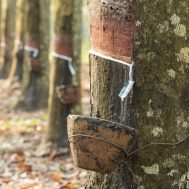Humans have been using rubber to create products for hundreds of years. The earliest evidence of rubber use comes from the Olmec culture of Mesoamerica, who used natural rubber materials to create balls for ball games. Today, rubber is an incredibly common and versatile material that is used in the creation of thousands of products, ranging from cookware to rubber gloves to tires and more. While most rubber products today are made from synthetic rubber, natural rubber was considered the superior option for a significant time.
In this two part series, we’ll be taking a look at how both natural and synthetic rubber are created and how they’re used. Read on for our discussion on the creation of natural rubber.
Uses Prior to World War II
Prior to World War II, significant uses of natural rubber included door and window profiles, hoses, belts, gaskets, matting, flooring, and automotive dampeners. The use of rubber in car tires consumed a significant amount of rubber, as did gloves and toy balloons. Rubber was used as an adhesive in many manufacturing industries and products, the two most significant of which were the paper and the carpet industries. Rubber was also commonly used to make rubber bands and pencil erasers.
The production of synthetic rubber greatly expanded during World War II, which we will discuss in the second part of this series.
Where does natural rubber come from?
Natural rubber is made by extracting latex – the liquid sap – from certain types of trees and other plants. While most latex is sourced from the Hevea brasiliensis tree, aka the rubber tree, over 2,500 varieties of trees and plants (including dandelions) produce the right kind of sap.
Latex is harvested through a process called tapping. It is done by making a cut in the bark of a tree and collecting the runny sap that comes out in cups. In order to prevent the sap from solidifying, ammonia is added. Acid is then added to the mix to extract the rubber, in a process called coagulation.
This mixture is then passed through rollers to remove excess water. Once rolling is complete, the layers of rubber are hung over racks in smokehouses or left out to air dry. Several days later, they will be ready for processing.
Processing natural rubber
Even natural rubber needs to undergo a series of processes in order to turn it into a usable product.
Firstly, chemicals are added to the rubber to make it stable. These chemicals may vary depending on the intended use of the rubber. Without this process, the rubber would become brittle in cold or sticky in high heat. A carbon black filler is often added to the rubber mix at this stage to improve its strength and durability. The rubber is mixed, cooled, and shaped.
Vulcanization
In order to make rubber strong and durable, it goes through a heat-treatment phase known as vulcanization. Essentially, the rubber is cooked to create extra bonds or cross-links between the molecules of the rubber so they don’t easily fall apart. After vulcanization, the rubber is harder and more durable. The process of vulcanization was an accidental discovery of engineer Charles Goodyear in 1839. Having accidentally dropped a piece of sulfur-coated rubber onto a hot stove, causing it to char and metamorphose into a leather-like substance, the American inventor uncovered the secret to stabilizing the latex of the rubber tree.
Limitations
Natural rubber was considered superior to synthetic rubber alternatives for a significant part of history. However, developments during World War II, which we will discuss in more detail in part two of this series, changed this. It’s important to note that while natural rubber has a great many applications, like tires, and dampening applications, it is no longer considered a good option for the sealing industry, especially when there is a chance of oil contact. Natural rubber will absorb oil until the rubber itself has disintegrated, meaning that it cannot be used to seal against oil. Another consideration is ozone, which causes natural rubber to break down over time.
For more information about rubber, natural or synthetic, contact the engineers at Apple Rubber!
